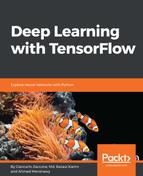In this example, we'll define and train either a two-layer model or a convolutional model in the style of LeNet 5:
from six.moves import xrange
import tensorflow as tf
import prettytensor as pt
from prettytensor.tutorial import data_utils
tf.app.flags.DEFINE_string(
'save_path', None, 'Where to save the model checkpoints.')
FLAGS = tf.app.flags.FLAGS
BATCH_SIZE = 50
EPOCH_SIZE = 60000 // BATCH_SIZE
TEST_SIZE = 10000 // BATCH_SIZE
Since we are feeding our data as numpy arrays, we need to create placeholders in the graph. These must then be fed using the feed dict.
image_placeholder = tf.placeholder
(tf.float32, [BATCH_SIZE, 28, 28, 1])
labels_placeholder = tf.placeholder
(tf.float32, [BATCH_SIZE, 10])
tf.app.flags.DEFINE_string('model', 'full',
'Choose one of the models, either
full or conv')
FLAGS = tf.app.flags.FLAGS
We created the following function, multilayer_fully_connected. The first two layers are fully connected (100 neurons), and the final layer is a softmax result layer. Note that the chaining layer is a very simple operation:
def multilayer_fully_connected(images, labels):
images = pt.wrap(images)
with pt.defaults_scope
(activation_fn=tf.nn.relu,l2loss=0.00001):
return (images.flatten().
fully_connected(100).
fully_connected(100).
softmax_classifier(10, labels))
In the following, we'll build a multilayer convolutional network; the architecture is similar to that defined in LeNet 5. Please change this to experiment with other architectures:
def lenet5(images, labels):
images = pt.wrap(images)
with pt.defaults_scope
(activation_fn=tf.nn.relu, l2loss=0.00001):
return (images.conv2d(5, 20).
max_pool(2, 2).
conv2d(5, 50).
max_pool(2, 2).
flatten().
fully_connected(500).
softmax_classifier(10, labels))
Since we are feeding our data as numpy arrays, we need to create placeholders in the graph. These must then be fed using the feed dict:
def main(_=None):
image_placeholder = tf.placeholder
(tf.float32, [BATCH_SIZE, 28, 28, 1])
labels_placeholder = tf.placeholder
(tf.float32, [BATCH_SIZE, 10])
Depending on FLAGS.model, we may have a two-layer classifier or a convolutional classifier, previously defined:
def main(_=None):
if FLAGS.model == 'full':
result = multilayer_fully_connected
(image_placeholder, labels_placeholder)
elif FLAGS.model == 'conv':
result = lenet5(image_placeholder, labels_placeholder)
else:
raise ValueError
('model must be full or conv: %s' % FLAGS.model)
Then we define the accuracy function for the evaluated classifier:
accuracy = result.softmax.evaluate_classifier
(labels_placeholder,phase=pt.Phase.test)
Next, we build the training and test sets:
train_images, train_labels = data_utils.mnist(training=True)
test_images, test_labels = data_utils.mnist(training=False)
We will use a gradient descent optimizer procedure and apply it to the graph. The pt.apply_optimizer function adds regularization losses and sets up a step counter:
optimizer = tf.train.GradientDescentOptimizer(0.01)
train_op = pt.apply_optimizer
(optimizer,losses=[result.loss])
We can set save_path in the running session to automatically checkpoint every so often. Otherwise, at the end of the session, the model will be lost:
runner = pt.train.Runner(save_path=FLAGS.save_path)
with tf.Session():
for epoch in xrange(10):
Shuffle the training data:
train_images, train_labels =
data_utils.permute_data
((train_images, train_labels))
runner.train_model(train_op,result.
loss,EPOCH_SIZE,
feed_vars=(image_placeholder,
labels_placeholder),
feed_data=pt.train.
feed_numpy(BATCH_SIZE,
train_images,
train_labels),
print_every=100)
classification_accuracy = runner.evaluate_model
(accuracy,
TEST_SIZE,
feed_vars=(image_placeholder,
labels_placeholder),
feed_data=pt.train.
feed_numpy(BATCH_SIZE,
test_images,
test_labels))
print('epoch' , epoch + 1)
print('accuracy', classification_accuracy )
if __name__ == '__main__':
tf.app.run()
Running this example provides the following output:
>>>
Extracting /tmp/data/train-images-idx3-ubyte.gz
Extracting tmp/data/train-labels-idx1-ubyte.gz
Extracting /tmp/data/t10k-images-idx3-ubyte.gz
Extracting /tmp/data/t10k-labels-idx1-ubyte.gz
epoch = 1
Accuracy [0.8994]
epoch = 2
Accuracy [0.91549999]
epoch = 3
Accuracy [0.92259997]
epoch = 4
Accuracy [0.92760003]
epoch = 5
Accuracy [0.9303]
epoch = 6
Accuracy [0.93870002]
epoch = 7
epoch = 8
Accuracy [0.94700003]
epoch = 9
Accuracy [0.94910002]
epoch = 10
Accuracy [0.94980001]
